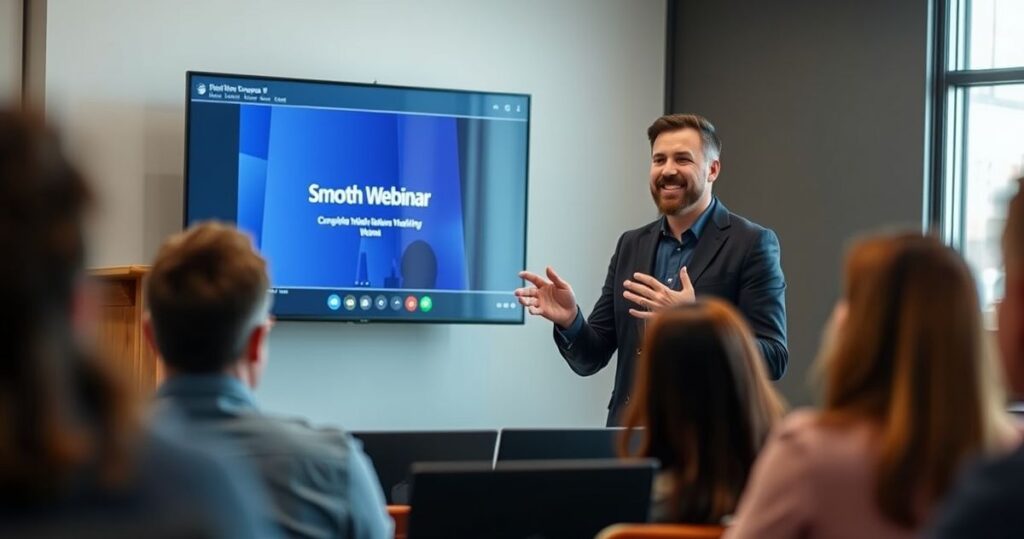How to Keep a Webinar Flowing Smoothly Without Awkward Pauses

How to Keep a Webinar Flowing Smoothly Without Awkward Pauses
Webinars are a powerful tool for engaging audiences, delivering valuable content, and converting leads. But let’s be honest: Few things derail a webinar faster than awkward pauses, stilted transitions, or technical hiccups. A smooth-flowing webinar isn’t just about what you say—it’s about how you say it, how you transition between topics, and how you handle the unexpected. Whether you’re a seasoned presenter or a first-time host, keeping your webinar flowing seamlessly is essential for maintaining audience engagement and achieving your goals. So, how do you eliminate those cringe-worthy pauses and deliver a polished, professional experience? Let’s dive in.
The Anatomy of a Smooth Webinar Flow
A well-structured webinar feels effortless, like a conversation with a trusted friend. But behind the scenes, it’s the result of meticulous planning, preparation, and practice. The key elements of a smooth flow include:
- Clear structure: A logical progression of topics
- Engaging transitions: Smooth shifts between sections
- Confident delivery: Natural pacing and tone
- Audience interaction: Strategic engagement points
- Technical preparedness: Minimizing disruptions
Think of your webinar as a movie. Each scene (or section) should flow naturally into the next, keeping the audience hooked and avoiding jarring jumps or confusing gaps.
Planning Your Webinar Structure
Let’s start with the foundation: your webinar outline. Without a clear structure, even the most charismatic presenter can stumble. Here’s how to plan your flow:
- Start with a strong opening: Hook your audience in the first 60 seconds. Use a surprising stat, a compelling story, or a thought-provoking question.
- Divide your content into sections: Break your material into digestible chunks, each with a clear purpose. Use headings like “Introduction,” “Core Content,” “Case Study,” “Q&A,” etc.
- Plan transitions: Think about how you’ll move from one section to the next. Phrases like “Now that we’ve covered X, let’s dive into Y” can work wonders.
- End with a call to action: Don’t just stop—conclude with a clear next step for your audience.
Eliminating Awkward Pauses: Pro Tips
Awkward pauses are often the result of uncertainty—uncertainty about what to say next, how to transition, or how to handle technical issues. Here’s how to banish them for good:
- Rehearse, rehearse, rehearse: Practice your webinar multiple times. Familiarity with your material will boost your confidence and reduce hesitation.
- Use prompts: Keep a script or note cards handy for key points, but don’t read word-for-word. Use them as safety nets, not crutches.
- Embrace silence: Not every pause is awkward. A brief pause can emphasize a point or give your audience time to absorb information.
- Learn your tech: Test your equipment, software, and internet connection beforehand. Know how to troubleshoot common issues like audio dropouts or screen sharing problems.
Engaging Your Audience for a Natural Flow
Audience interaction isn’t just about keeping people engaged—it’s also a tool for maintaining flow. Here’s how to use it effectively:
- Polls and quizzes: Break up your content with quick, interactive elements. They’re a great way to gauge understanding and keep energy high.
- Q&A sessions: Schedule dedicated time for questions, but also invite them throughout the webinar. It keeps the conversation dynamic.
- Chat participation: Encourage attendees to share thoughts or questions in the chat. Acknowledge their comments to create a two-way dialogue.
Real-World Example: From Clunky to Smooth
Let me share a case study from a recent client. They were hosting a webinar to promote a new software tool, but their first attempt was riddled with awkward pauses and disjointed transitions. Here’s how we fixed it:
- Restructured the outline: We streamlined the content into three clear sections and added defined transitions.
- Added interactive elements: We inserted a poll after the introduction and a Q&A session halfway through.
- Rehearsed with tech: The presenter practiced using the webinar platform, ensuring smooth screen sharing and audio clarity.
The result? A 25% increase in attendee engagement and a 15% boost in conversions.
Handling Technical Glitches Gracefully
Even the best-laid plans can’t prevent all technical issues. The key is to handle them gracefully:
- Stay calm: Acknowledge the issue with humor or patience. “Looks like our internet is taking a coffee break—bear with us for a moment!”
- Have a backup plan: If one tool isn’t working, switch to another. For example, if screen sharing fails, use a pre-recorded video instead.
- Communicate with your team: If you have a co-host or tech support, establish clear signals or messages for troubleshooting.
Final Thoughts: Practice Makes Perfect
Keeping a webinar flowing smoothly is both an art and a science. It requires careful planning, confident delivery, and a willingness to adapt. But the payoff is worth it: a webinar that engages your audience, builds trust, and drives results.
So, the next time you’re preparing for a webinar, ask yourself: Does my structure make sense? Are my transitions seamless? Am I ready to handle the unexpected? With these strategies in your toolkit, you’ll be well on your way to delivering a flawless, pause-free experience.



